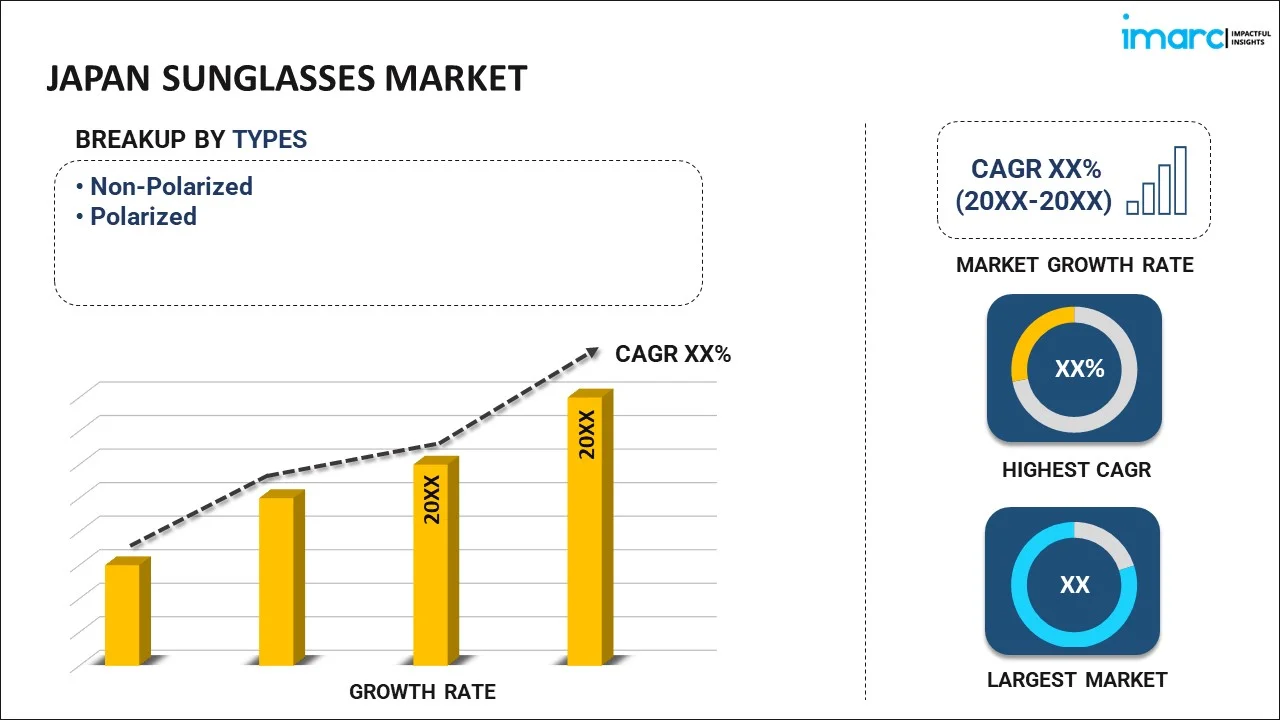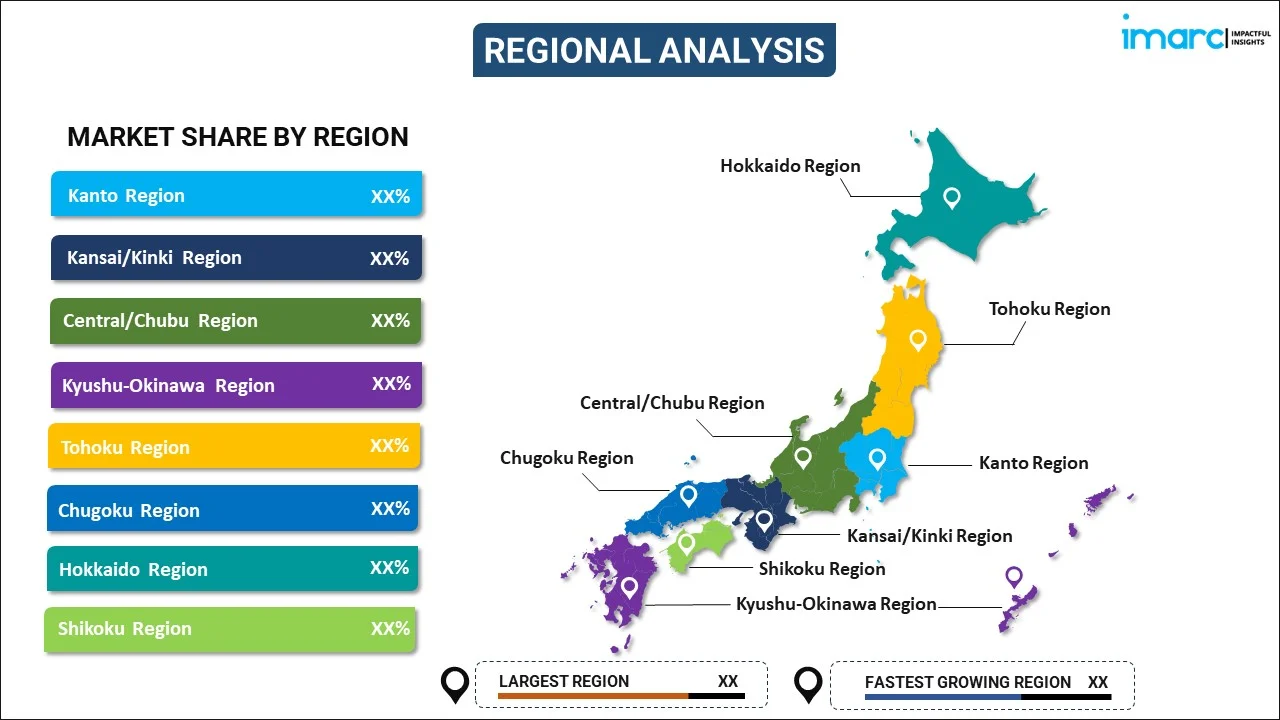
Japan Sunglasses Market Report by Type (Non-Polarized, Polarized), Design (Round, Aviator/Pilot, Rectangle, Square, Oval, Cat Eye, and Others), Frame Material (Injected, Acetate, Metal, and Others), Lens Material (Polycarbonate, CR-39, Polyurethane, and Others), Distribution Channel (Offline, Online), End User (Men, Women, Unisex), and Region 2025-2033
Market Overview:
Japan sunglasses market size reached USD 1.4 Billion in 2024. Looking forward, IMARC Group expects the market to reach USD 2.2 Billion by 2033, exhibiting a growth rate (CAGR) of 4.2% during 2025-2033. The increasing innovations in lens technologies, such as polarized lenses, photochromic lenses, and anti-reflective coatings, which have made sunglasses more functional and appealing to consumers, are driving the market.
|
Report Attribute
|
Key Statistics
|
|---|---|
|
Base Year
|
2024
|
|
Forecast Years
|
2025-2033
|
|
Historical Years
|
2019-2024
|
|
Market Size in 2024
|
USD 1.4 Billion |
|
Market Forecast in 2033
|
USD 2.2 Billion |
| Market Growth Rate 2025-2033 | 4.2% |
Sunglasses are more than just a fashion accessory; they serve a crucial purpose in protecting the eyes from the harmful effects of the sun. These tinted lenses not only shield the eyes from the intense brightness of sunlight but also safeguard them from potentially damaging ultraviolet (UV) rays. Sunglasses come in a wide variety of styles, shapes, and colors, catering to both functional and aesthetic preferences. Beyond fashion, they provide essential eye protection, reducing the risk of conditions like cataracts, macular degeneration, and photokeratitis caused by UV exposure. Furthermore, sunglasses are a versatile accessory that can instantly elevate the look, adding an air of mystery, sophistication, or playfulness. They have become an integral part of many outdoor activities, from sports to leisurely strolls, making them indispensable in daily life. So, whether it's shielding the eyes from harmful rays or making a style statement, sunglasses are a must-have accessory for both protection and fashion-conscious individuals.
Japan Sunglasses Market Trends:
The sunglasses market in Japan is experiencing robust growth due to several key drivers. Firstly, changing consumer lifestyles has played a pivotal role in boosting demand for sunglasses. As people become more health conscious, the awareness of the harmful effects of UV rays on eye health has increased, prompting individuals to invest in protective eyewear. Moreover, the fashion industry's influence has been a significant driving force. Sunglasses are no longer just a practical accessory; they have become a fashion statement. Consequently, consumers are inclined to purchase multiple pairs to match their various outfits and styles. In addition to this, technological advancements have contributed to market expansion. The development of polarized and photochromic lenses, as well as anti-glare coatings, has enhanced the functionality of sunglasses, making them more appealing to consumers. Additionally, increasing awareness of eye protection in sports and outdoor activities has boosted demand for specialized sports sunglasses. Furthermore, the rise of e-commerce, which has made sunglasses more accessible, allowing customers to browse a wide range of options online and make convenient purchases, is expected to drive the regional sunglasses market in the coming years.
Japan Sunglasses Market Segmentation:
IMARC Group provides an analysis of the key trends in each segment of the market, along with forecasts at the country level for 2025-2033. Our report has categorized the market based on type, design, frame material, lens material, distribution channel, and end user.
Type Insights:

- Non-Polarized
- Polarized
The report has provided a detailed breakup and analysis of the market based on the type. This includes non-polarized and polarized.
Design Insights:
- Round
- Aviator/Pilot
- Rectangle
- Square
- Oval
- Cat Eye
- Others
A detailed breakup and analysis of the market based on the design have also been provided in the report. This includes round, aviator/pilot, rectangle, square, oval, cat eye, and others.
Frame Material Insights:
- Injected
- Acetate
- Metal
- Others
The report has provided a detailed breakup and analysis of the market based on the frame material. This includes injected, acetate, metal, and others.
Lens Material Insights:
- Polycarbonate
- CR-39
- Polyurethane
- Others
A detailed breakup and analysis of the market based on the lens material have also been provided in the report. This includes polycarbonate, CR-39, polyurethane, and others.
Distribution Channel Insights:
- Offline
- Online
The report has provided a detailed breakup and analysis of the market based on distribution channel. This includes offline and online.
End User Insights:
- Men
- Women
- Unisex
A detailed breakup and analysis of the market based on the end user have also been provided in the report. This includes men, women, and unisex.
Regional Insights:

- Kanto Region
- Kansai/Kinki Region
- Central/ Chubu Region
- Kyushu-Okinawa Region
- Tohoku Region
- Chugoku Region
- Hokkaido Region
- Shikoku Region
The report has also provided a comprehensive analysis of all the major regional markets, which include Kanto Region, Kansai/Kinki Region, Central/ Chubu Region, Kyushu-Okinawa Region, Tohoku Region, Chugoku Region, Hokkaido Region, and Shikoku Region.
Competitive Landscape:
The market research report has also provided a comprehensive analysis of the competitive landscape. Competitive analysis such as market structure, key player positioning, top winning strategies, competitive dashboard, and company evaluation quadrant has been covered in the report. Also, detailed profiles of all major companies have been provided.
Japan Sunglasses Market Report Coverage:
| Report Features | Details |
|---|---|
| Base Year of the Analysis | 2024 |
| Historical Period | 2019-2024 |
| Forecast Period | 2025-2033 |
| Units | Billion USD |
| Scope of the Report | Exploration of Historical Trends and Market Outlook, Industry Catalysts and Challenges, Segment-Wise Historical and Future Market Assessment:
|
| Types Covered | Non-Polarized, Polarized |
| Designs Covered | Round, Aviator/Pilot, Rectangle, Square, Oval, Cat Eye, Others |
| Frame Materials Covered | Injected, Acetate, Metal, Others |
| Lens Materials Covered | Polycarbonate, CR-39, Polyurethane, Others |
| Distribution Channels Covered | Offline, Online |
| End Users Covered | Men, Women, Unisex |
| Regions Covered | Kanto Region, Kansai/Kinki Region, Central/ Chubu Region, Kyushu-Okinawa Region, Tohoku Region, Chugoku Region, Hokkaido Region, Shikoku Region |
| Customization Scope | 10% Free Customization |
| Post-Sale Analyst Support | 10-12 Weeks |
| Delivery Format | PDF and Excel through Email (We can also provide the editable version of the report in PPT/Word format on special request) |
Key Questions Answered in This Report:
- How has the Japan sunglasses market performed so far and how will it perform in the coming years?
- What has been the impact of COVID-19 on the Japan sunglasses market?
- What is the breakup of the Japan sunglasses market on the basis of type?
- What is the breakup of the Japan sunglasses market on the basis of design?
- What is the breakup of the Japan sunglasses market on the basis of frame material?
- What is the breakup of the Japan sunglasses market on the basis of lens material?
- What is the breakup of the Japan sunglasses market on the basis of distribution channel?
- What is the breakup of the Japan sunglasses market on the basis of end user?
- What are the various stages in the value chain of the Japan sunglasses market?
- What are the key driving factors and challenges in the Japan sunglasses?
- What is the structure of the Japan sunglasses market and who are the key players?
- What is the degree of competition in the Japan sunglasses market?
Key Benefits for Stakeholders:
- IMARC’s industry report offers a comprehensive quantitative analysis of various market segments, historical and current market trends, market forecasts, and dynamics of the Japan sunglasses market from 2019-2033.
- The research report provides the latest information on the market drivers, challenges, and opportunities in the Japan sunglasses market.
- Porter's five forces analysis assist stakeholders in assessing the impact of new entrants, competitive rivalry, supplier power, buyer power, and the threat of substitution. It helps stakeholders to analyze the level of competition within the Japan sunglasses industry and its attractiveness.
- Competitive landscape allows stakeholders to understand their competitive environment and provides an insight into the current positions of key players in the market.
Need more help?
- Speak to our experienced analysts for insights on the current market scenarios.
- Include additional segments and countries to customize the report as per your requirement.
- Gain an unparalleled competitive advantage in your domain by understanding how to utilize the report and positively impacting your operations and revenue.
- For further assistance, please connect with our analysts.
 Inquire Before Buying
Inquire Before Buying
 Speak to an Analyst
Speak to an Analyst
 Request Brochure
Request Brochure
 Request Customization
Request Customization




.webp)




.webp)












